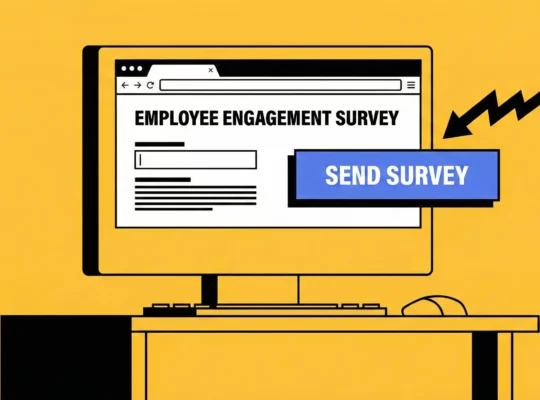The Employee Net Promoter Score is a powerful tool for HR professionals aiming to enhance employee experience and foster a thriving workplace. This metric offers a snapshot of employee loyalty and provides valuable insights into organizational health. In this comprehensive guide, we’ll explore how to understand, analyze eNPS data, and transform those insights into tangible actions that drive positive change within your organization.
What is eNPS and How Does it Work?
The Employee Net Promoter Score (Employee Net Promoter Score (eNPS)) is designed to measure employee loyalty and willingness to recommend their company as a good place to work. Its straightforward approach makes it easy to implement and understand.
The eNPS Question:
The cornerstone of the eNPS methodology is a single, direct question: “How likely are you to recommend this company as a place to work?” This question cuts through the noise and gets straight to the heart of how employees feel about their employer.
The 0-10 Scale and Categorization:
Respondents answer on a scale of 0 to 10, which allows for clear and simple categorization:
- Promoters (9-10): These are your most loyal and enthusiastic employees. They act as advocates for the company and are deeply satisfied with their work experience.
- Passives (7-8): These employees are generally satisfied, but they lack the enthusiasm and strong loyalty of promoters. They may be open to opportunities elsewhere.
- Detractors (0-6): This group represents employees who are dissatisfied with their work experience. They might actively discourage others from working at the company.
eNPS Score Calculation:
The eNPS score calculation is straightforward: subtract the percentage of Detractors from the percentage of Promoters. The formula ensures that the final score falls between -100 and +100. This overall score helps you understand the general sentiment of your workforce.
% Promoters – % Detractors = eNPS Score
For example, if 60% of your employees are Promoters and 15% are Detractors, your eNPS score would be 45.
Why eNPS Matters:
The key reason eNPS matters is quite simple. The tool measures employee loyalty and their willingness to recommend the organization. This provides a valuable indicator of overall employee satisfaction and the strength of the employer brand.
Analyzing eNPS Data: Uncovering Actionable Insights
Once you’ve gathered your eNPS data, the real work begins: eNPS analysis. This step involves extracting meaningful insights that can drive positive change within your organization.
Understanding Your eNPS Score:
While a higher score is usually seen as a good indicator, context is paramount. A “good” score varies widely depending on the industry and other factors. Focus on understanding the distribution of promoters, passives, and detractors within your workforce. Establishing benchmarks and tracking trends is far more valuable than fixating on a single score. For added efficacy, link eNPS data with other HR data (performance, turnover).
Benchmarking eNPS Scores:
Benchmarking your eNPS against industry averages, competitors, or similar-sized organizations offers valuable perspective. This will help you to measure employee satisfaction accurately in regards to the standards of your industry. Sources like SurveyMonkey provide industry-specific eNPS benchmarks that can serve as a starting point. Keep factors like industry, location, and company size in mind, as these can significantly affect your eNPS benchmarks. Treat benchmarks as a guide, not a definitive measure of success. Compare your scores in the areas of industry standards.
Below is a table outlining some sample eNPS benchmarks across various industries:
| Industry | Average eNPS Range |
| Technology | 20-40 |
| Healthcare | 10-30 |
| Retail | 5-20 |
| Manufacturing | 0-15 |
| Financial Services | 15-35 |
Segmentation is Key:
Segment your eNPS data to pinpoint areas of concern within your workforce. This allows you to identify specific groups of employees who may have lower or higher sentiments. Look into demographics of the segmented data.
Consider segmenting by:
- Department/teams: Different teams may have varying work environment and management styles.
- Location: Geographical differences can impact employee morale and satisfaction.
- Tenure: Employee sentiment can shift over time, so analyze eNPS based on how long employees have been with the company.
- Other relevant demographics (age, gender, job level, etc.)
By segmenting, you can identify specific areas needing your attention.
Beyond the Numbers: The Importance of Qualitative Feedback:
Remember that eNPS survey findings are just the beginning. Always follow with qualitative data to understand the “why” behind the numbers. Without this, you will never know how to improve eNPS.
Use follow-up questions to uncover the drivers of negative or positive employee sentiment, which will help identify the drivers of eNPS. For example:
- “What is the primary reason for your score?”
- “What could we do differently to improve your experience?”
- “What do you value most about working here?”
These open-ended questions provide valuable context and help you understand how to take action on feedback.
Combining eNPS Data with Other HR Metrics:
The true power of eNPS analysis comes into play when you combine it with other HR metrics. For instance, if a department shows a low eNPS score and high turnover, it might signal issues with management or the company culture. Similarly, linking eNPS to performance data could reveal whether disengaged employees are also underperforming.
Consider linking eNPS with data on:
- Employee performance
- Turnover rates
- Employee engagement scores (from other surveys)
- Absenteeism rates
- Training and development participation
Implementing an Effective eNPS Program
A well-designed eNPS program is essential for gathering actionable insights and driving positive change.
Choosing the Right eNPS Platform/Tool:
Many options exist for conducting eNPS surveys, ranging from simple survey platforms to comprehensive HR software. Consider factors like:
- Ease of use for both administrators and employees
- Anonymous feedback capabilities
- Reporting and eNPS reporting features
- Integration with existing HR systems
- Sentiment analysis functionalities (if available)
Some companies also find custom-built solutions tailored to their unique needs.
Best Practices for eNPS Surveys:
To maximize the effectiveness of your eNPS program, follow these best practices:
- Frequency: Decide on the right survey rhythm. Pulse surveys conducted frequently (e.g., monthly or quarterly) provide regular check-ins, while longer intervals (e.g., semi-annually or annually) offer a broader perspective.
- Anonymity: Ensure complete anonymity to encourage honest and eNPS feedback. Clearly communicate this to employees.
- Response Rate: Aim for a high response rate to ensure your data is representative. Promote the survey, explain its importance, and keep it concise.
- Transparency: Share the eNPS results with employees and explain how you plan to act on the feedback.
- Follow-up Questions: Design thoughtful follow-up questions that elicit specific and useful information. Avoid leading questions or those that imply a desired answer.
Addressing the Criticisms of eNPS:
Acknowledge the limitations of eNPS. It is a single-question metric that inherently simplifies complex factors that affect employee engagement. The eNPS methodology might not provide granular insights into specific engagement drivers. The eNPS survey, while easy to administer, might not uncover the full picture.
Use it as one component of a broader employee engagement strategy.
Utilizing the eNPS as an “Early Warning System”
Treat the eNPS program as an “early warning system” for potential issues. A sudden drop in the eNPS score can signal problems with morale, leadership, or the work environment. Use this to proactively address concerns and prevent employee retention.
Taking Action: Turning eNPS Insights into Tangible Improvements
Collecting eNPS data is only worthwhile if you translate those findings into meaningful action.
Communicating eNPS Results:
Openly share eNPS results with employees, fostering transparency and trust. Present the data in a clear and accessible format and encourage open discussion of the results.
Developing Action Plans Based on Feedback:
Based on the themes emerging from the response analysis and eNPS feedback, develop targeted action plans to address the concerns of detractors and passives. Ensure these plans are specific, measurable, achievable, relevant, and time-bound (SMART).
Addressing Specific Issues Identified:
Take concrete steps to address the specific issues that are driving negative eNPS. For example if the data finds that the company culture is a reoccurring issue, you can change the culture through implementing team building and promoting the company values. Or if issues with management practices are found, offer leadership training. Also, if employee benefits are determined to be lacking, assess employee needs and make improvements. Addressing these issues will help to improve employee experience.
Tracking the Impact of Your Actions:
Once you’ve implemented changes, track the impact on your eNPS score over time. Regular monitoring helps you see whether your initiatives are making a difference and identify any adjustments needed. This ensures that you continue to improve employee experience. Regularly measuring eNPS helps monitor employee sentiment and identify trends.
Boosting Employee Loyalty and Advocacy
The ultimate goal of an eNPS program is to strengthen employee loyalty and foster employee advocacy.
Turning Detractors into Passives (and Passives into Promoters):
Actively engage with detractors to understand their concerns, and genuinely work to address them. For passives, identify opportunities to increase their engagement and make them feel more valued. Creating a positive work environment that fosters loyalty will make a big difference.
Leveraging Your Promoters:
Recognize and reward your promoters for their positive eNPS and employee advocacy. Encourage them to share their positive experiences both within and outside the organization. As loyal employee advocates do good, ensure their actions are being recognized. Highlight the link between eNPS and employee referrals, since promoters are more likely to recommend your company to their network.
Effectively analyzing eNPS offers the power to transform your HR strategies, creating a more engaged, loyal, and satisfied workforce. By combining quantitative eNPS data with qualitative feedback, you can gain actionable insights that drive real change. Remember that eNPS is most effective when used in conjunction with other engagement initiatives, helping you build a thriving and happy workforce.
Ready to measure eNPS, analyze eNPS, and implement eNPS improvements? At Review.jobs, we’re here to help you leverage the power of employee reviews and insights to build a better workplace.
FAQs
What is eNPS?
eNPS is a metric used to measure. It is simply a number representing how willing employees are to recommend their workplace to others.
Why is eNPS Important?
eNPS is important because. The Employee Morale metric can help identify areas for improvement in the employee experience. It also provides a quantifiable way to track eNPS and measure the effects of engagement initiatives.
Who Uses eNPS?
HR departments use eNPS to obtain employee sentiment and organizational health. Leaders and managers also use the eNPS information to inform plans to increase employee engagement.
When Should eNPS Surveys Occur?
eNPS surveys can be conducted regularly using pulse surveys. This will allow you to get a constant insight of the employee experience at the organization.
Where Does eNPS Data Come From?
The eNPS data originates from an eNPS survey asking one question that measures employee loyalty. This data is a tool to address issues that the HR department uncovers with the survey.
How Can We Improve eNPS?
You can improve eNPS by acting on the eNPS feedback. Some ways you can do that is by improving communication, addressing specific issues, and recognizing employee promoters to boost employee advocacy.





